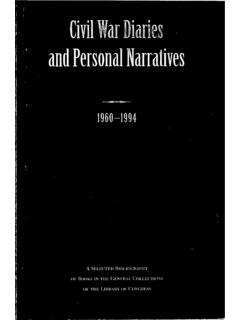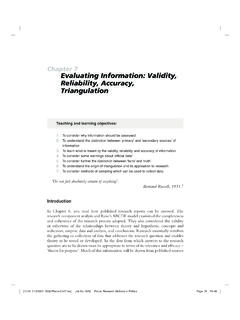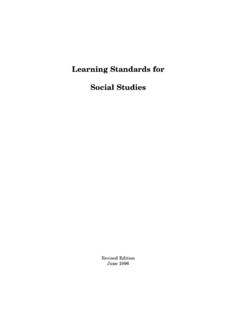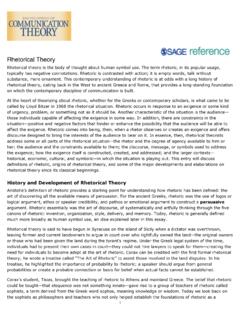Transcription of Nazi Germany and the Jews, 1933-1945
1 nazi Germany AND THE JEWS, 1933 1945 ABRIDGED EDITIONSAUL FRIEDL NDERA bridged by Orna KenanTo U n aCONTENTSF oreword Acknowledgments xiiiMaps xPA RT O N E : PERSECUTION(Januar y 1933 August 1939)1. Into the Third Reich: January 1933 December 1933 32. The Spirit of the Laws: January 1934 February 1936 323. Ideology and Card Index: March 1936 March 1938 614. Radicalization: March 1938 November 1938 875. A Broken Remnant: November 1938 September 1939 111PA RT T WO : TERROR(September 1939 December 1941)6. Poland Under German Rule: September 1939 April 1940 1437. A New European Order: May 1940 December 1940 171vv 8. A Tightening Noose: December 1940 June 1941 200 9. The Eastern Onslaught: June 1941 September 1941 22910. The Final Solution : September 1941 December 1941 259PA RT T H R E E : SHOAH(Januar y 1942 May 1945)11. Total Extermination: January 1942 June 1942 28712. Total Extermination: July 1942 March 1943 31613.
2 Total Extermination: March 1943 October 1943 34514. Total Extermination: Fall 1943 Spring 1944 37415. The End: March 1944 May 1945 395 Notes 423 Selected Bibliography 449 Index 457 CONTENTSivAbout the AuthorAbout the AbridgerOther Books by Saul FriedlanderCreditsCoverCopyrightAbout the PublisherFOREWORDThis abridged edition of Saul Friedl nder s two volume his-tory of nazi Germany and the Jews is not meant to replace the original. Ideally it should encourage its readers to turn to the full-fledged version with its wealth of details and interpre-tive nuances, which of necessity could not be rendered here. Nonetheless, whatever the constraints imposed by an abridge-ment, the prime goal of the present work has been to render faithfully Friedl nder s highly original integrative approach to the history of the persecution and extermination of European Jewry between 1933 and 1945. The policies of the perpetrators, the attitudes of surrounding society, as well as the initiatives and reactions of the victims are interwoven in a unified nar-rative.
3 This type of simultaneous representation at all levels and in all different places enables the reader better to grasp the magnitude, depth, and multilayered evolution of the events, and to perceive correlations and comparisons hardly apparent immediate impulse for writing this history, according to the author, derived from the debates of the mid-1980s known as the historians controversy (Historikerstreit) and, more specifically, from the ensuing debate between himself and the director of the Munich-based Institute for Contemporary His-tory, Martin Broszat, about the historicization of National Socialism. Broszat s main criticism was directed against the traditional representation of the Third Reich as a simplistic, black-and-white rendition of good and evil, whereas a full FOREWORD rendition (Gesamtdarstellung) demanded many shades of gray. Within this context the Munich scholar contended in partic-ular that the Jewish survivors perception of this past, as well as that of their descendants, albeit worthy of respect, repre-sented a mythical memory (that is, a subjective version of their experiences) that set a coarsening obstacle in the path of a rational German historiography, based as it were upon a scientific, dispassionate analysis of the particular, Broszat argued, as a consequence of their biased perspective, the victims tended to set the criminality of the nazi regime at center stage and thus saw it as defining the entire history of the Third Reich.
4 In his view the nazi years s h o u l d b e t r e a t e d a s a n y n o r m a l p e r i o d of h i s t o r y. R a t h e r t h a n be analyzed from hindsight, from the known outcome (the im-plementation of the Final Solution of the Jewish Question ), the nazi period should be followed in a forward direction, in keeping with historical methodology. Moreover, Broszat noted, the Final Solution was made possible precisely because it was systematically concealed from and thus unperceived by the German population until shortly before the end of the war; this lack of awareness of the worst crimes of the regime allowed for an ongoing normality of everyday life for the immense ma-jority of Germans living under National to Broszat s interpretation, Friedl nder ques-tioned the nature of the normality of everyday life in the Third Reich prior to the onset of the Final Solution (late fall 1941) by showing the extraordinary impact of the regime s anti-Jewish propaganda on the national-racial community (Volk sge-meinschaft), the awareness of the open persecution of the Jews and other targeted groups before the beginning of the war, and the early and rapidly spreading knowledge and generally tacit acceptance (often the complicit support)
5 Among the German population of the crimes of the regime, specifically of mass murder and, from 1942 on, of total FOREWORDAlso in direct contradistinction to Broszat s argument, nazi Germany and the Jews, sets a major emphasis on the vic-tims voices in the writing and interpretation of this history. These voices, not as expressed in fallible memoirs (no more fallible of course than those of a H ss or a Speer, among any number of nazi memorialists and witnesses), but as expressed in the immediate perception of the hundreds of diarists and correspondents whose texts have been retrieved recorded the minutest details of their own individual world, including the initiatives and daily brutality of the perpetrators, the re-actions of populations, and the life and death of their commu-nities. These most immediate testimonies about dimensions of ongoing events, usually unperceived in other sources, do confirm intuitions, warn us against easy generalizations, and tear through the smugness of scholarly detachment.
6 Though, at times, they do repeat the known, they do so with un-matched , such personal chronicles, such individual Jewish voices, restore to these events a sharpness of focus that had been progressively lost in recent years through the emphasis in historiographical writing on interpretations essentially foregrounding abstract structures and mindless bureaucratic dynamics. They also add a crucial dimension to the under-standing of previously persistent questions about the behavior of the victims and thus about the unfolding of the killing pro-cess as such: The reading of diaries and letters, for example, clearly shows that while the populations throughout Europe were becoming aware of the extermination of the Jews, the victims themselves, with the exception of a tiny minority, did not know what was ultimately in store for them. In Western and in Central Europe the Jews were somehow unable to piece the information together; in the East, the Jewish populations in their immense majority did not believe the precise details that trickled into their segregated communities.
7 The historical viiFOREWORD significance of this inability of the Jews to grasp the fate that awaited them, or rather, their defensive refusal to do so, ex-plains, at least in part, the notorious passivity of the Jewish masses and thus the smoothness of the entire process of major trends in present-day historiography of the Third Reich perceive the criminal policies of the regime within a global context in which the Jewish question becomes but a secondary, almost derivative, issue: The extermination of the Jews is interpreted as the consequence of a nazi plan to achieve economic and demographic equilibrium in occupied Europe by way of murdering surplus populations (among whom Jews were but one of the targeted groups). The Final Solution is also explained as a first stage in a wider ethnic reshuffling and decimation of Eastern populations in order to facilitate German colonization of Eastern spaces.
8 It has similarly been presented as aiming at the systematic plunder of the Jews of Europe in order to alleviate the material burden of the war for the benefit of the German , in Friedl nder s study the extermination of the Jews, who were deemed the main enemy of nazi Germany , was a major goal in and of itself. Robbing the victims of all their assets constituted but a secondary benefit deriving from the mass murder itself. Otherwise, why would the nazi leader have personally decided in the fall of 1943 to forge ahead with the deportation of the Jews of Denmark and those of Rome, notwithstanding the serious risks involved (the possibility of unrest in Denmark and that of the pope s public protest) and the nonexistent benefits of both operations? What was the ur-gency and benefit, for that matter, in deporting the poor Jewish communities of the Aegean islands in July 1944, and the hun-dreds of Jewish children from Paris three days before the lib-eration of the city?
9 ViiixFOREWORDF urthermore, for Friedl nder the anti-Jewish obsession that became characteristic of the regime s self-image, and that in-spired the relentlessness of its murder policies to the very last moment, cannot be explained without setting Hitler at center stage: From his first letter on a political issue, sent in September 1919, up to the main exhortations of his political testament (and to its very final line), written on the eve of his suicide, the anti-Jewish struggle was at the core of the German messiah s faith and worldview. Without the obsessive anti-Semitism and the personal impact of Adolf Hitler, first as the leader of the move-ment, then on the national scene, the widespread German anti-Semitism of those years would probably not have coalesced into systematic anti-Jewish policies and certainly not into their murderous , according to the author, ideology as such specifically anti-Jewish ideology ultimately played a central role among the factors that drove nazi policies on an ever more radical path to the most thoroughly organized genocide in modern history.
10 All in all, Goebbels noted after a long conversation with Hitler at the end of April 1944, a long-term policy in this war is only possible if one considers it from the standpoint of the Jewish Question. Indeed, the logic behind this anti-Jewish passion stemmed from the ominous image of the Jew as the lethal and relentlessly active enemy of the Reich, intent on its destruction. Thus, within the same hallucinatory logic, once the Reich had to fight on both fronts, east and west, without the hope of a rapid victory and with some early intimations of defeat, Hitler opted for immediate extermination. Otherwise, as he saw it, the Jews would destroy Germany and the new Europe from lethal image of the Jew as an irreducibly destructive force did not come from nowhere. During the immediate pre- nazi decades, the anti-Semitism of diverse national, social, and re-ix FOREWORD ligious groups in Germany and throughout Europe expressed itself in different constructs under changing circumstances and in distinct political frameworks.










